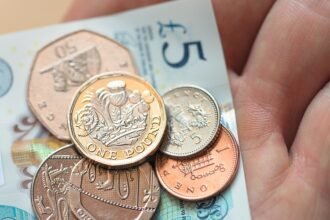- GBP/USD struggles to stabilize above 1.3300 on Monday.
- Technical sellers could take action if 1.3270 support fails.
- The Fed and the BoE will announce monetary policy decisions later this week.
GBP/USD lost 0.3% last week and snapped a three-week winning streak. The pair enters a consolidation phase on Monday and trades below 1.3300.
British Pound PRICE Last 7 days
The table below shows the percentage change of British Pound (GBP) against listed major currencies last 7 days. British Pound was the weakest against the Australian Dollar.
| USD | EUR | GBP | JPY | CAD | AUD | NZD | CHF | |
|---|---|---|---|---|---|---|---|---|
| USD | 0.38% | 0.27% | 0.40% | -0.41% | -1.22% | -0.20% | -0.47% | |
| EUR | -0.38% | -0.17% | 0.02% | -0.80% | -1.68% | -0.58% | -0.85% | |
| GBP | -0.27% | 0.17% | 0.19% | -0.62% | -1.53% | -0.41% | -0.67% | |
| JPY | -0.40% | -0.02% | -0.19% | -0.80% | -1.59% | -2.00% | -0.60% | |
| CAD | 0.41% | 0.80% | 0.62% | 0.80% | -0.93% | 0.21% | -0.04% | |
| AUD | 1.22% | 1.68% | 1.53% | 1.59% | 0.93% | 1.13% | 0.86% | |
| NZD | 0.20% | 0.58% | 0.41% | 2.00% | -0.21% | -1.13% | -0.26% | |
| CHF | 0.47% | 0.85% | 0.67% | 0.60% | 0.04% | -0.86% | 0.26% |
The heat map shows percentage changes of major currencies against each other. The base currency is picked from the left column, while the quote currency is picked from the top row. For example, if you pick the British Pound from the left column and move along the horizontal line to the US Dollar, the percentage change displayed in the box will represent GBP (base)/USD (quote).
GBP/USD closed virtually unchanged on Friday as the US Dollar (USD) struggled to gather strength following the April labor market data from the US.
The Bureau of Labor Statistics (BLS) reported that Nonfarm Payrolls (NFP) increased by 177,000 in April. This reading surpassed the market expectation of 130,000. However, the BLS announced that it revised February and March NFP prints lower by 43,000 and 15,000, respectively. Other details of the employment report showed that the Unemployment Rate remained unchanged at 4.2%, while the Labor Force Participation Rate ticked up to 62.6% from 62.5% in March.
In the second half of the day, the ISM will publish the Services Purchasing Managers’ Index (PMI) report for April. In case the headline PMI disappoints, with a reading below 50, the USD could come under pressure and help GBP/USD find support.
Later in the week, the Federal Reserve (Fed) and the Bank of England (BoE) will announce monetary policy decisions. Hence, investors could opt to stay on the sidelines and ignore the data releases in the immediate term.
GBP/USD Technical Analysis

The Relative Strength Index (RSI) indicator on the 4-hour chart stays near 40 and GBP/USD continues to trade below the 100-period, 50-period and 20-period Simple Moving Averages (SMA), reflecting a lack of buyer interest.
On the downside, 1.3270 (Fibonacci 23.6% retracement of the latest uptrend) aligns as a key support level. A daily close below this level could attract technical sellers and open the door for an extended slide toward 1.3220 (20-day SMA) and 1.3165 (Fibonacci 38.2% retracement). Looking north, resistances could be located at 1.3300 (100-period SMA), 1.3330-1.3340 (50-period SMA, static level) and 1.3400 (round level, static level).
Pound Sterling FAQs
The Pound Sterling (GBP) is the oldest currency in the world (886 AD) and the official currency of the United Kingdom. It is the fourth most traded unit for foreign exchange (FX) in the world, accounting for 12% of all transactions, averaging $630 billion a day, according to 2022 data.
Its key trading pairs are GBP/USD, also known as ‘Cable’, which accounts for 11% of FX, GBP/JPY, or the ‘Dragon’ as it is known by traders (3%), and EUR/GBP (2%). The Pound Sterling is issued by the Bank of England (BoE).
The single most important factor influencing the value of the Pound Sterling is monetary policy decided by the Bank of England. The BoE bases its decisions on whether it has achieved its primary goal of “price stability” – a steady inflation rate of around 2%. Its primary tool for achieving this is the adjustment of interest rates.
When inflation is too high, the BoE will try to rein it in by raising interest rates, making it more expensive for people and businesses to access credit. This is generally positive for GBP, as higher interest rates make the UK a more attractive place for global investors to park their money.
When inflation falls too low it is a sign economic growth is slowing. In this scenario, the BoE will consider lowering interest rates to cheapen credit so businesses will borrow more to invest in growth-generating projects.
Data releases gauge the health of the economy and can impact the value of the Pound Sterling. Indicators such as GDP, Manufacturing and Services PMIs, and employment can all influence the direction of the GBP.
A strong economy is good for Sterling. Not only does it attract more foreign investment but it may encourage the BoE to put up interest rates, which will directly strengthen GBP. Otherwise, if economic data is weak, the Pound Sterling is likely to fall.
Another significant data release for the Pound Sterling is the Trade Balance. This indicator measures the difference between what a country earns from its exports and what it spends on imports over a given period.
If a country produces highly sought-after exports, its currency will benefit purely from the extra demand created from foreign buyers seeking to purchase these goods. Therefore, a positive net Trade Balance strengthens a currency and vice versa for a negative balance.





















